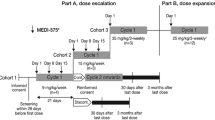Abstract
Purpose: A phase I study was performed to determine the maximum tolerated dose (MTD), safety profile and pharmacology of aprinocarsen (ISIS 3521), an antisense oligonucleotide to protein kinase C-α, in patients with refractory solid tumors. Experimental design: Fourteen patients were treated in sequential cohorts of aprinocarsen by 24-hour continuous infusion (CIV), weekly, at doses of 6, 12, 18 and 24 mg/kg. Results: One grade 4 toxicity was observed, transient grade 4 neutropenia at 18 mg/kg. Grade 3 toxicities included neutropenia at 12 mg/kg, fever and hemorrhage at 18 mg/kg, and neutropenia, nausea, and chills at 24 mg/kg. Grade 2 toxicities included thrombocytopenia myalgias, chills, headache, fatigue, fever and nausea/vomiting. Mean prothrombin times and activated partial thromboplastin times (aPTT) increased by 10% and 29% from baseline (p = 0.006 and 0.005). Mean complement split products (Bb and C3a) increased 1.6-fold and 3.6-fold (from p = 0.014 and 0.004, respectively). These changes correlated with dose and were transient with recovery to baseline by day 7. Steady state plasma concentrations (Css) of aprinocarsen were achieved within four hours. Css better described changes in aPTT than dose. Clinical evidence of complement activation was not observed. Conclusions: In contrast to 21-day protracted infusion schedules, delivery of aprinocarsen over a 24-hour infusion schedule showed concentration-dependent effects on coagulation and complement, which are consistent with nonclinical toxicology studies performed in the phosphorothioate DNA antisense drug class. These coagulation and complement changes resulted in a maximum tolerated dose 24 mg/kg.
Similar content being viewed by others
References
Basu A: The potential of protein kinase C as a target for anticancer treatment. Pharmacol Ther 59: 257–280, 1993
Blobe GC, Obeid LM, Hannun YA: Regulation of protein kinase C and role in cancer biology. Cancer Metastasis Rev 13: 411–431, 1994
Henry SP, Montheith D, Bennett F, Levin AA: Toxicological and pharmacokinetic properties of chemically modified antisense oligonucleotide inhibitors of PKC-α and C-raf kinase. Anticancer Drug Des 12: 409–420, 1997
Dean NM, McKay R: Inhibition of protein kinase C-α expression in mice after systemic administration of phosphorothioate antisense oligodeoxynucleotides. Proc Natl Acad Sci USA 91: 11762–11766, 1994
Yazaki T, Ahmad S, Chahlavi A, Zylber-Katz E, Dean NM, Rabkin SD, Martuza RL, Glazer RI: Treatment of glioblastoma U-87 by systemic administration of an antisense protein kinase C-α phosphorothioate oligodeoxynucleotide. Mol Pharmacol 50: 236–242, 1996
Yuen AR, Halsey J, Fisher GA, Holmlund JT, Geary RS, Kwoh TJ, Dorr A, Sikic BI: Phase I study of an antisense oligonucleotide to protein kinase C-α (ISIS 3521/CGP 64128A) in patients with cancer. Clin Cancer Res 5: 3357–3363, 1999
Galbraith WM, Hobson WC, Giclas PC, Schechter PJ, Agrawal S: Complement activation and hemodynamic changes following intravenous administration of phosphorothioate oligonucleotides in the monkey. Antisense Res Dev 4: 201–206, 1994
Leeds JM, Graham MJ, Truong L, Cummins LL: Quantitation of phosphorothioate oligonucleotides in human plasma. Anal Biochem 235: 36–43, 1996
Mick R, Ratain MJ: Statistical approaches to pharmacodynamic modeling: Motivations, methods, and misperceptions. Cancer Chemother Pharmacol 33: 1–9, 1993
Crooke ST, Bennett CF: Progress in antisense oligonucleotide therapuetics. Annu Rev Pharmacol Toxicol 36: 107–129, 1996
Nemunaitis J, Holmlund JT, Kraynak M, Richards D, Bruce J, Ognoskie N, Kwoh TJ, Geary R, Dorr A, Von Hoff D, Eckhardt SG: Phase I evaluation of ISIS 3521, an antisense oligodeoxynucleotide to protein kinase C-alpha, in patients with advanced cancer. J Clin Oncol 17: 3586–3595, 1999
Holmlund J, Nemunaitis J, Schiller J, Dorr A, Kisner D: Phase I trial of C-raf antisense oligonucleotide ISIS 5132 (CGP 69846A) by 21-day continuous intravenous infusion (CIV) in patients with advanced cancer (Abstract). Proc Am Soc Clin Oncol 17: 811a, 1998
Sheehan JP, Lan HC: Phosphorothioate Oligonucleotides inhibit the intrinsic tenase complex. Blood 92: 1617–1625, 1998
Henry SP, Novotny W, Leeds J, Auletta C, Kornbrust DJ: Inhibition of coagulation by a phosphorothioate oligonucleotide. Antisense Nucleic Acid Drug Dev 7: 503–510, 1997
Henry SP, Giclas PC, Leeds J, Pangburn M, Auletta C, Levin AA, Kornbrust DJ: Activation of the alternative pathway of complement by a phosphorothioate oligonucleotide: Potential mechanism of action. J Pharmacol Exp Ther 281: 810–816, 1997
Geary RS, Leeds JM, Henry SP, Monteith DK, Levin AA: Antisense oligonucleotide inhibitors for the treatment of cancer: Pharmacokinetic properties of phosphorothioate oligodeoxynucleotides. Anticancer Drug Des 12: 383–393, 1997
Author information
Authors and Affiliations
Corresponding author
Rights and permissions
About this article
Cite this article
Advani, R., Lum, B.L., Fisher, G.A. et al. A phase I trial of aprinocarsen (ISIS 3521/LY900003), an antisense inhibitor of protein kinase C-α administered as a 24-hour weekly infusion schedule in patients with advanced cancer. Invest New Drugs 23, 467–477 (2005). https://doi.org/10.1007/s10637-005-2906-0
Issue Date:
DOI: https://doi.org/10.1007/s10637-005-2906-0




